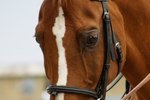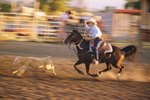
You might have heard the expression "horses for courses," meaning that what suits one person doesn't work for everybody. In the equine world, the type of horse developed for a particular sport or activity might not do well in other equine pursuits because of its body structure. Good conformation in any horse is important, but when apprising a horse's body structure, it's important to take into consideration what endeavors might best suit that individual animal.
Analyzing Conformation
Horse aficionados have probably seen charts comparing the well-conformed equine with the one who has every conformational fault imaginable. While most horses have some faults, analyzing their body structure gives you a good idea of whether that animal can do a particular job or stay sound over time. You're looking for balance and proportion. A well-conformed horse can be divided into three equal sections. As noted by Washington State University Extension, "A horse can be divided equally only if it has a long, sloping shoulder; a short back with a corresponding long underline; and long hip." If you're analyzing a horse who doesn't fall within that division, you know it has some important conformational flaws.
The Front
The horse's head and neck should move freely. The head should be proportional, while the neck should be long and without concavity. A medium-size chest is preferable to either a thin or wide one, both of which affect the horse's way of moving. Looking at the horse's legs from the front, you should ideally see a straight line from his forearm, knee, cannon bone, fetlock and heel bulb, all centering under the points of his shoulder. His pasterns should be neither too long or too upright, but with a medium slope. The shoulder should appear long, muscular and sloping into the back. This allows freedom of movement and increased stride length.
The Middle
The all-important back carries the rider, but excessive length is undesirable. Long backs indicate a weak structure. The back should be straight and muscular. Look for well-sprung ribs, those rounding outward on the barrel, which provide sufficient room for lung expansion during athletic activities.
The Rear
The rear is the horse's "engine." Structurally, a horse should have a long croup, or rump, turning evenly at the top and without a steep angle. Heavily muscled, short loins indicate power in the hind end. Looking at the horse from the rear, ideally you can drop a plumb line from the lower, muscular part of his thigh -- the gaskin -- to his foot, so that his hock, cannon bones and fetlock all line up.
Bone Structure
It's a great compliment when you're told your horse has "good bone." That means his bone structure appears substantial and appropriate to his size. Heavy-bodied horses on fragile-looking legs are apt to suffer from all sorts of lameness and are likely to have a short working life. That extends to the feet -- as the saying goes, "No hoof, no horse." Stay away from big-boned horses with dainty feet. You don't have to be psychic to predict future hoof problems.
References
Photo Credits
-
Comstock/Comstock/Getty Images
Writer Bio
Jane Meggitt has been a writer for more than 20 years. In addition to reporting for a major newspaper chain, she has been published in "Horse News," "Suburban Classic," "Hoof Beats," "Equine Journal" and other publications. She has a Bachelor of Arts in English from New York University and an Associate of Arts from the American Academy of Dramatics Arts, New York City.



